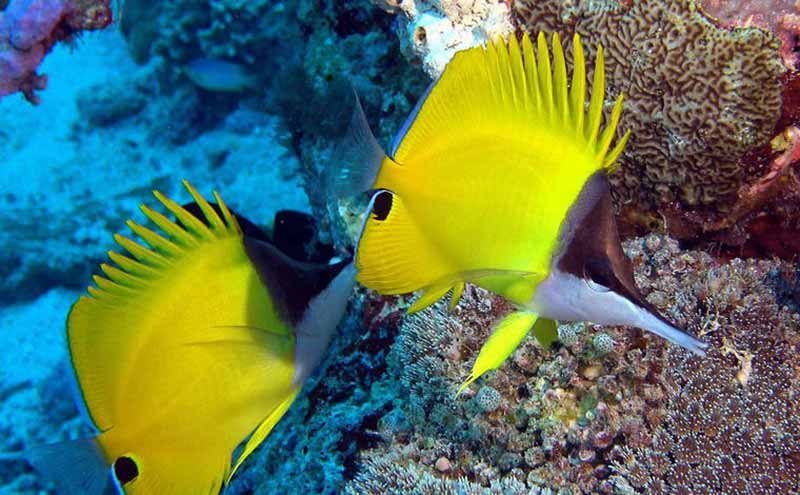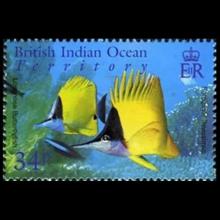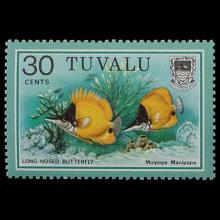NAMES
TAXONOMY
British Indian Ocean Territory
Issued:
Stamp:
Forcipiger longirostris
Tuvalu
Issued:
Stamp:
Forcipiger longirostris
British Indian Ocean Territory
Issued:
Stamp:
Forcipiger longirostris
Tuvalu
Issued:
Stamp:
Forcipiger longirostris
British Indian Ocean Territory
Issued:
Stamp:
Forcipiger longirostris
Tuvalu
Issued:
Stamp:
Forcipiger longirostris
Meet lauwiliwili nukunuku ‘oi‘oi
By Terry Lilley Critter of the week | Sunday, June 30, 2019, 12:05 a.m.
Meet the way-cool longnose butterflyfish, whose Hawaiian name is “lauwiliwili nukunuku ‘oi’oi,” which just happens to be one of the longest names of any Hawaiian fish. Maybe that is because it is so special and beautiful! The wonderful Hawaiian language describes fish in a way that you can learn something about each fish. The name tells you about the fish’s behavior, color, pattern or relationship to the coral reef and plants or animals that live on land! The Hawaiian people learned that all creatures are connected and thrive on this beautiful connection! Each underwater creature has a connection with a plant or animal on land! The name of this fish means “it looks like the leaf or flower of the wiliwili tree, and has the best, sharp-pointed beak.” The name describes the fish quite well. When we see this fish it is often feeding on soft sponges that grow on the reef, and these sponges are in caves, cracks and between corals that are hard to get to. This amazing fish has developed a long beak to poke deep into the cracks to grab its favorite food! I have also observed this fish eating reef worms, shrimp and even dead fish, so they are opportunistic feeders that know a good meal when they see it!

The funny thing about the English name of this fish is where “butterflyfish” came from. Does it look like butter flying by? No. The original name came from India over 200 years ago when the British explorers first saw butterflies! They describe these insects as “flutter bys,” as they fluttered by their heads! Somehow when they got back to England someone mixed up the name and called them butterflies! The wonderful part of Hawaiian history is the way they named the sea creatures here that described their behavior and relationship to the islands, so their names did not get lost due to someone’s interpretation! Hawaii has 1,800 years of an amazing culture that knew every creature that lived in the sea and on land and understood the relationship between all of these creatures. To see lauwiliwili nukunuku ‘oi‘oi in all of her beautiful colors visit the website www.underwater2web.com, where she is featured in the movie “The World’s Guide To Hawaiian Reef Fish.” Those with children who wish to experience these fish and many other species in person may the Marine Science School at the nonprofit www.reefguardianshawaii.org.
Genus species (Animalia): Forcipiger longirostris
Forcipiger longirostris, commonly known as the longnose butterflyfish or big longnose butterflyfish, is a species of butterflyfish found on coral reefs throughout the tropical waters of the Indo-Pacific. Even with its distinctive, point-like long nose, the longnose butterflyfish still can easily be confused with its more common cousin F. flavissimus. Both species may be kept in aquariums.
Description
Forcipiger longirostris has a compressed yellow body with a black triangular region on its head, and as the name implies, a long, silvery snout. Usually 10 or 11 dorsal spines, a black spot on the anal fin, and rows of small black spots on the breast are found. The fish grows to about 22 cm (8.7 in) in length. In comparison, Forcipiger flavissimus has more dorsal spines, lacks the black spots, and its operculum is more curved.
Rarely, Forcipiger longirostris can be found in an all-black form, as well, or the yellow portion may be brown.
Taxonomy
The wonderful Hawaiian language describes fish in a way that you can learn something about each fish. The name of this fish means “it looks like the leaf or flower of the wiliwili tree, and has the best, sharp-pointed beak.”
Reference: Wikipedia



